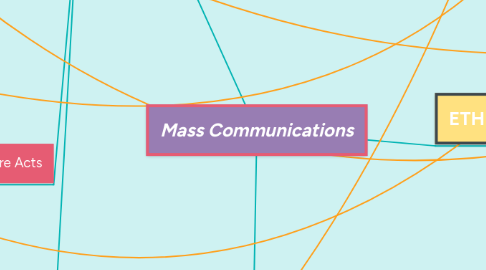
1. LAW
1.1. First Amendment Rights
1.1.1. Freedom of Religion
1.1.1.1. Protects Right to not assoicate
1.1.2. Right to Petition
1.1.2.1. Includes right to file a law suit
1.1.3. Freedom of Press
1.1.3.1. Times v. Sullivan
1.1.3.1.1. Types of figures
1.1.3.1.2. Establishes "Actual Malice"
1.1.3.2. Near v. Minnesota
1.1.3.3. Times v. U.S.
1.1.3.4. Hustler v. Falwell
1.1.4. Freedom of Speech
1.1.4.1. Brandenburg v. Ohio
1.1.4.2. U.S. v. Schenk
1.1.4.3. Chaplinsky v. New Hampshire
1.1.4.4. Texas v. Johnson
1.1.4.5. Zeran v. American Online, Inc.
1.1.4.6. Carfano v. Metrosplash.com
1.1.4.7. Tinker v. Des Moines
1.1.5. Right to Peaceably Assemble
1.2. Legislature Acts
1.2.1. Communications Decency Act of 1996
1.2.2. Freedom of Information Act
1.2.3. Right to Privacy
1.2.3.1. Intrusion
1.2.3.2. False Light
1.2.3.3. Missappropriation
1.2.3.4. Public Disclosure of Private Facts
1.3. SCOTUS's Role
1.3.1. Free Speech is not absolute
1.3.2. Government can limit speech in certain circumstances
2. DIVERSITY
2.1. Demographic
2.1.1. Mainly White
2.1.1.1. Entertainment
2.1.1.2. Journalism
2.1.1.3. Public Relations
2.1.2. Younger Employees show more Diversity
2.2. Diversity Necessity
2.2.1. Business Imperative
2.2.1.1. Reach New Audiences
2.2.2. Journalism Imperative
2.2.2.1. Better Serve Community
2.2.3. Economic Profit
2.2.3.1. Diversity leads to higher profit
2.3. Intersectionality
2.3.1. Tips to recognize intersectional audience
2.3.1.1. Recognize differences
2.3.1.2. Avoid oversimplified language
2.3.1.3. Analyze the space you occupy
2.3.1.4. Seek other points of view
2.3.1.5. Show up for their causes
2.4. Dimensions of Diversity
2.4.1. Race
2.4.2. Religion
2.4.3. Gender
2.4.4. Sexual Orientation
2.4.5. Political Beliefs
3. ETHICS
3.1. Codes of Ethics
3.1.1. Protecting Sources and Victims
3.1.1.1. Whistleblower
3.1.2. Privacy vs. News Value
3.1.3. Transparency; Conflicts of Interest
3.1.4. Integrity
3.1.5. Competence
3.1.6. Confidentiality
3.2. Technology
3.2.1. Social Media
3.2.1.1. Regularly Use it to Communicate
3.2.1.2. No Partisan Opinions
3.2.1.3. No Offensive Comments
3.2.2. Digital Media
3.2.2.1. The Internet
3.2.2.1.1. Information-Sharing
3.2.2.1.2. Networking
3.2.2.1.3. Anybody can say anything
3.3. Privacy
3.3.1. Public Interest
3.3.2. Private lives
3.4. General Characteristics of Ethics
3.4.1. Heterogeneity
3.4.2. Interconnectivity
3.4.3. Historicity
3.4.4. Integrity
3.4.4.1. Truth
3.4.4.2. Truth-telling
3.4.4.3. Truthfulness
3.5. Modes of Ethical Reasoning
3.5.1. Deontological
3.5.2. Teleological
3.5.3. Modernist
3.5.4. Enlightenment
3.5.5. Dialogic
3.6. Thinking Ethically Approaches
3.6.1. Utilitarian Approach
3.6.2. Rights Approach
3.6.3. Fairness/Justice Approach
3.6.4. Common-Good Approach
3.6.5. Virtue
